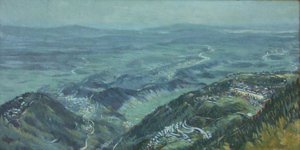Dharamsala
|
|
LocationDharamsala.png
Dharamsala or Dharmsāla, (literally; "Rest House") is a town in the northern Indian state of Himachal Pradesh.
Dharamsala is located in the Kangra valley, in the Dhauladhar mountains. It became the capital of the Kangra District in 1852.
Dharamsala has been connected with Buddhism for a long time, with many monasteries having been established there in the past. In the 8th century, however, these monasteries are believed to have declined, with Hinduism experiencing a revival. The local Gaddi people are now almost all Hindu.
In 1848, the area was annexed by the British, and a year later, a military garrison was established in the town. Dharamsala eventually became the administrative capital of Kangra District in 1852. It became a popular hill station for the British working in or near Delhi, offering a cool respite during the hot summer months.
However, the town was virtually destroyed in a massive earthquake in 1905, which killed an estimated 40,000 people. After this, the British moved their summer headquarters to Shimla (also written Simla) which, though not far away, is off the main fault line and, therefore, less likely to experience a serious earthquake.
When the Dalai Lama left Tibet, Indian Prime Minister Jawaharlal Nehru offered to permit him and his followers to establish a "government-in-exile" in Dharamsala. Since that point, many Tibetan exiles have settled in the town, numbering several thousand. Most of these exiles live in Upper Dharamsala, or McLeod Ganj, where they established temples and schools. The town is sometimes known as "Little Lhasa", after the Tibetan capital city.
The natural features surrounding the town are extremely beautiful and feature rich forests of pine and deodars.
Stupa_&_prayer_wheels._Main_street,_McLeod_Ganj.jpg
The town is divided between Upper Dharamsala or McLeod Ganj (which retains a British colonial atmosphere), and Lower Dharamsala (the commercial centre). Upper Dharamsala (elevation about 1,700 m or 5,580 ft) is about 9 kilometers (5.6 miles) from Lower Dharmsala by road and is some 460 m (1,510 ft) higher.
McLeod Ganj, or Upper Dharamsala, is the residence of Tenzin Gyatso, the current Dalai Lama. A substantial community of Tibetan exiles resides in the town. There is also a beautiful small Anglican church, St. John of the Wilderness, featuring some exceptional stained-glass windows, just a few hundred metres from McLeod Ganj.
There are some excellent treks from here to Triund, (3,350 m or 10,991 ft), Inderhara Pass (4,300 m or 14,108 ft) and to other beauty spots in the Dhauladhar range.
The area covered by Dharamsala is almost 29 km². During the months of December and January, snowfall is common and the temperature ranges from 0 °C to 14.5 °C. During summers, the temperature ranges from 22 °C to 38 °C. The best times to visit are from March to June or September to November.
There is an airport about 20 km away. Rice, wheat and tea are grown around Dharmsala.
References
- Verma, V. 1996. Gaddis of Dhauladhar: A Transhumant Tribe of the Himalayas. Indus Publishing Co., New Delhi.
- Handa, O. C. 1987. Buddhist Monasteries in Himachel Pradesh. Indus Publishing Co., New Delhi. ISBN 81-85182-03-5.
External links
- 123Himachal profile (http://123himachal.com/dasaguide.htm)
- [1] (http://www.dharamsalanet.com/index.htm) "Dharamsala Net" with lots of links about Dharamsala.
McCleod_Ganj_main_street.jpg


